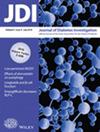Precision medicine in diabetes prediction: Exploring a subgroup-specific biomarker strategy for risk stratification
Abstract
Introduction
The early detection of high-risk individuals is crucial to delay and reduce the incidence of type 2 diabetes. In this study, we aimed to explore the performance of a novel subgroup-specific biomarker strategy in the prediction of incident diabetes.
Materials and Methods
In the Taiwan Lifestyle Cohort Study, adult subjects without diabetes were included and followed for the incidence of diabetes in 2006–2019. The biomarkers measured included blood secretogranin III (SCG3), vascular adhesion protein-1 (VAP-1), fibrinogen-like protein 1 (FGL1), angiopoietin-like protein 6 (ANGPTL6), and angiopoietin-like protein 4 (ANGPTL4).
Results
Among the 1,287 subjects, 12.2% developed diabetes during a 6 year follow-up. Blood VAP-1 was significantly associated with incident diabetes in the overall population (HR = 0.724, P < 0.05), participants under 65 years old (HR = 0.685, P < 0.05), those with a BMI of ≥24 kg/m2 (HR = 0.673, P < 0.05), and females (HR = 0.635, P < 0.05). Blood ANGPTL6 was significantly correlated with incident diabetes in participants aged 65 and older (HR = 0.314, P < 0.05), and blood SCG3 was associated with incident diabetes in those with a BMI of <24 kg/m2 (HR = 1.296, P < 0.05). Two subgroup-specific biomarker strategies were developed. The gender and BMI-specific biomarker strategy, using traditional risk factors and blood SCG3 or VAP-1 in different subgroups, could improve prediction performance, especially the specificity and positive prediction value, compared with the whole-population strategy using only traditional risk factors or traditional risk factors plus blood VAP-1.
Conclusion
Gender- and BMI-specific biomarker strategy can improve the prediction of incident diabetes. A subgroup-specific biomarker strategy is a novel approach in the prediction of incident diabetes.


 求助内容:
求助内容: 应助结果提醒方式:
应助结果提醒方式:


